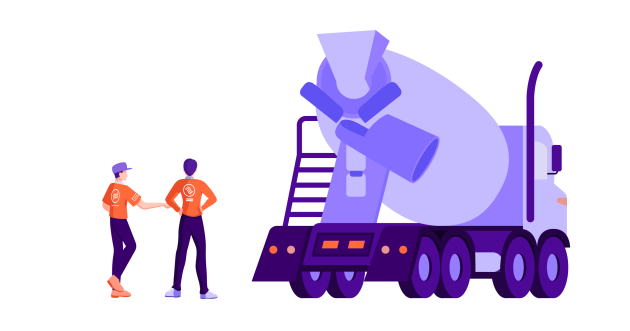Best Practices for Wheel Loader Maintenance

Uncover the secrets to top-notch wheel loader maintenance that will keep your operations running smoothly and your productivity soaring. Get ready to revitalise your wheel loaders with our expert tips and unleash their full potential on the field!
From understanding the key components of a wheel loader to performing daily maintenance checks, periodic tasks, and implementing preventive maintenance programs, we’ll cover all the necessary steps to help you optimise the performance and lifespan of your wheel loaders.
The field service industry is faced with many challenges on a daily basis, that’s why automation is so important. With asset management software you can effectively ensure smooth operations and maximise productivity.
Maintaining wheel loaders is crucial for ensuring their optimal performance, extending their lifespan, and minimising downtime. In this blog post, we will explore the key practices and steps involved in effective wheel loader maintenance. Let’s begin!
Understanding the Key Components of a Wheel Loader
A wheel loader consists of several vital components that require regular maintenance to keep the machine running smoothly. These components include:
- Engine: The engine is the heart of a wheel loader and needs regular attention. Routine maintenance includes oil changes, filter replacements, and inspection of belts, hoses, and coolant levels. (Including cooling system)
- Hydraulic System: The hydraulic system powers the loader’s movement and attachment functions. It’s essential to check hydraulic fluid levels, inspect hoses and fittings for leaks or damage, and ensure proper lubrication of moving parts.
- Bucket: The bucket is a critical component for loading and carrying materials. Regular inspection for wear and tear, maintaining proper alignment, and addressing any damage promptly is necessary for efficient operation.
- Tires: Wheel loader tires endure substantial stress and should be inspected regularly for cuts, punctures, and proper inflation. Regular rotation and alignment can help extend their lifespan.
Understanding the role and maintenance needs of these key components is crucial to keeping a wheel loader in optimal working condition. We will dive more into each section for your wheel loader’s maintenance and your routine daily maintenance schedule below.
Daily Maintenance Checks for Wheel Loaders
Performing daily maintenance checks is a proactive approach to prevent unexpected breakdowns and ensure the smooth operation of wheel loaders. From your wheel loader cooling systems to your lift cylinders, there is a lot that can go wrong for your machine, that’s why maintenance is vital.
Here’s a checklist of tasks to perform on a daily basis:
- Visual Inspection: Check for any visible damage, leaks, or loose parts.
- Fluid Levels: Verify and top up engine oil, hydraulic fluid, coolant, and fuel as needed.
- Tires and Wheels: Inspect tire pressure, look for cuts or wear, and tighten lug nuts if necessary.
- Lights and Signals: Test all lights, indicators, and warning signals to ensure they are functional.
- Filters: Check and clean or replace air filters as required.
By incorporating these daily wheel loader maintenance checks into your routine, you can identify potential issues early on and address them promptly, reducing the risk of unexpected breakdowns and maximising productivity. Always consult the manufacturer’s maintenance manual for your heavy equipment any queries on your wheel loader’s attachments or maintenance.
Periodic Maintenance for Wheel Loaders
In addition to daily checks, certain maintenance tasks need to be performed periodically to keep the wheel loader operating at its best. Some important routine maintenance elements for your wheel loader operators to consider include:
Changing Oil and Filters: Regularly change engine oil, hydraulic fluid, and filters according to the manufacturer’s recommendations.
Bucket and Linkage Inspection: Examine the bucket, cutting edge, and linkage components for wear, damage, or misalignment. Grease the moving parts as needed.
Greasing Moving Parts: Lubricate all pivot points, bearings, and joints with the appropriate grease to prevent premature wear.
Performing these periodic maintenance tasks helps ensure peak operating condition, prolongs the lifespan of the machine, and minimises the risk of unexpected failures. It’s highly important that you perform daily visual inspections and have a routine maintenance plan, you don’t want to get caught unawares.
Don’t forget maintenance training! Start training your team on the importance of recommended maintenance intervals and a thorough visual inspection to ensure you achieve quality performance.
Cleaning and Proper Storage of Wheel Loaders
You can avoid costly repairs with proper maintenance and cleaning. Proper cleaning and storage practices are essential for maintaining wheel loaders, especially during periods of non-use or inclement weather. Consider the following tips:
Cleaning: Regularly clean the machine, removing dirt, debris, and other contaminants. Pay close attention to radiator fins, air filters, and the undercarriage.
Corrosion Prevention: Apply protective coatings or rust inhibitors to vulnerable areas, such as exposed metal surfaces and the bucket.
Proper Storage: When storing the wheel loader, park it in a covered area away from direct sunlight, rain, or extreme temperatures. Use wheel chocks to prevent unintended movement.
By implementing these cleaning and storage practices, you can prevent corrosion, damage, and other potential issues that may arise from neglecting proper care.
The Importance of Maintenance Records for Wheel Loaders
Maintaining comprehensive maintenance records for your key systems is crucial for effective wheel loader maintenance. Keeping track of maintenance activities, repairs, and part replacements offers several benefits:
Compliance: Accurate records help meet regulatory requirements and standards for equipment maintenance.
Tracking Performance: Maintenance records provide insights into the machine’s performance over time, helping identify patterns, recurring issues, and areas for improvement.
Resale Value: Well-documented maintenance records can enhance the resale value of the wheel loader by demonstrating its proper care and maintenance history.
Establishing a system for creating and managing maintenance records, whether through digital solutions or traditional paper logs, ensures that important maintenance information is readily available when needed.
Dealing with Common Wheel Loader Maintenance Issues
Even with regular maintenance, certain issues may arise with wheel loaders. Here are some common problems and tips for addressing them:
Hydraulic System Leaks: Inspect hydraulic hoses, fittings, and seals for leaks. Replace damaged components promptly and replenish hydraulic fluid as necessary.
Electrical Malfunctions: Check fuses, relays, and wiring connections for any issues. If electrical problems persist, consult a professional technician for assistance.
Engine Performance Problems: Monitor engine performance, address unusual noises, and schedule regular tune-ups to maintain optimal engine functionality.
It’s important to note that some maintenance issues may require the expertise of a professional technician. Knowing when to seek professional assistance ensures that complex problems are properly resolved.
Benefits of a Preventive Maintenance Program for Wheel Loaders
Implementing a preventive maintenance program offers several advantages for wheel loader owners. Here are some benefits:
Increased Equipment Lifespan: Regular maintenance helps identify and address potential problems before they cause major damage, thereby extending the lifespan of the wheel loader.
Reduced Downtime: Scheduled maintenance minimises unexpected breakdowns, leading to reduced downtime and increased productivity.
Cost Savings: Preventive maintenance reduces the likelihood of costly repairs or component replacements, resulting in long-term cost savings.
Establishing a preventive maintenance program involves setting up a maintenance schedule, defining tasks, and assigning responsibilities. Leveraging technology, such as asset management software like FieldInsight, can streamline the process and improve maintenance efficiency.
Safety Measures in Wheel Loader Maintenance
Safety should be a top priority when performing maintenance on wheel loaders. By fostering a safety-conscious culture, you can ensure the well-being of operators and maintenance personnel. Here are some safety measures to consider:
Training: Provide comprehensive training on safe maintenance practices, including the use of personal protective equipment (PPE), proper lifting techniques, and lockout/tagout procedures.
Equipment Inspection: Regularly inspect tools, equipment, and safety devices to ensure they are in good working condition.
Communication: Encourage open communication between operators and maintenance personnel to report safety concerns and hazards promptly.
Prioritising safety during maintenance activities not only protects personnel but also contributes to better maintenance outcomes and lowers accident rates.
Harnessing FieldInsight for Wheel Loader Maintenance
FieldInsight, our comprehensive asset management software, can greatly simplify and enhance wheel loader maintenance. Here’s how FieldInsight can be beneficial:
Task Management: FieldInsight streamlines task allocation, scheduling, and tracking of maintenance activities, ensuring timely completion.
Maintenance Records: The software allows for easy creation, management, and retrieval of detailed maintenance records, keeping all information organised and accessible.
Predictive Maintenance: FieldInsight offers predictive maintenance capabilities, leveraging data analytics and machine learning to identify potential issues before they occur, maximising uptime.
By leveraging FieldInsight, you can optimise your wheel loader maintenance processes, improve efficiency, and make data-driven decisions to enhance overall performance.
Conclusion
In conclusion, effective wheel loader maintenance is vital for achieving optimal performance, prolonging the machine’s lifespan, and minimising downtime.
By understanding the key components, performing daily and periodic checks, implementing a preventive maintenance program, and prioritising safety, you can ensure the longevity and efficiency of your wheel loaders.
Don’t forget to explore FieldInsight as a comprehensive solution for managing wheel loader maintenance tasks efficiently.
Start optimising your wheel loader maintenance with FieldInsight today and experience the benefits of streamlined asset management.
What You Should Do Now
- Book a Demo. You’ll be in touch with an automation expert who has worked in this space for over 5 years, and knows the optimal workflow to address your needs.
- If you’d like access to free articles about managing HVAC workflows, go to our blog.
- If you know someone who’d enjoy reading this page, share it with them via email, Linkedin, Twitter, or Facebook.









